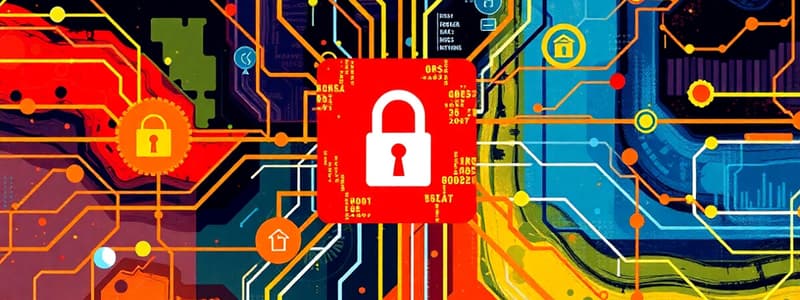Podcast
Questions and Answers
What is the primary purpose of data encryption?
What is the primary purpose of data encryption?
- To ensure data integrity
- To protect data confidentiality (correct)
- To facilitate data sharing
- To improve system performance
Why is regular vulnerability assessments important?
Why is regular vulnerability assessments important?
- They eliminate the need for firewalls.
- They improve network speed.
- They help detect new software updates.
- They identify weaknesses in systems. (correct)
Which component is essential for effective implementation of security measures?
Which component is essential for effective implementation of security measures?
- Employee training on security policies (correct)
- Public awareness campaigns
- Security software updates
- Physical security installations
What role does data classification play in security?
What role does data classification play in security?
What aspect does an incident response plan NOT address?
What aspect does an incident response plan NOT address?
What is the primary purpose of security policies within an organization?
What is the primary purpose of security policies within an organization?
Which of the following best describes security procedures?
Which of the following best describes security procedures?
How does the CDFOM contribute to security policy development?
How does the CDFOM contribute to security policy development?
Which aspect is NOT typically included in security policies?
Which aspect is NOT typically included in security policies?
What is a potential consequence of misalignment between CDFOM, security policies, and procedures?
What is a potential consequence of misalignment between CDFOM, security policies, and procedures?
Which of the following best illustrates the relationship between security policies and procedures?
Which of the following best illustrates the relationship between security policies and procedures?
Access controls are critical for what primary function?
Access controls are critical for what primary function?
Which of the following is NOT a key aspect of security policies?
Which of the following is NOT a key aspect of security policies?
Flashcards
Data Classification
Data Classification
A process of assigning levels of sensitivity to data based on its potential impact if compromised.
Incident Response Plan
Incident Response Plan
A set of procedures for responding to a security breach, including steps for containment, investigation, and recovery.
Vulnerability Assessments
Vulnerability Assessments
Regularly evaluating systems for vulnerabilities and weaknesses that could be exploited by attackers.
Penetration Testing
Penetration Testing
Signup and view all the flashcards
Physical Security
Physical Security
Signup and view all the flashcards
CDFOM (Classification and Data Flow Model)
CDFOM (Classification and Data Flow Model)
Signup and view all the flashcards
Security Policies
Security Policies
Signup and view all the flashcards
Security Procedures
Security Procedures
Signup and view all the flashcards
What benefit does CDFOM offer in terms of security?
What benefit does CDFOM offer in terms of security?
Signup and view all the flashcards
What do Security Policies define?
What do Security Policies define?
Signup and view all the flashcards
What do Security Procedures specify?
What do Security Procedures specify?
Signup and view all the flashcards
What is the importance of access controls in security?
What is the importance of access controls in security?
Signup and view all the flashcards
Why is a strong alignment between CDFOM, security policies, and procedures important?
Why is a strong alignment between CDFOM, security policies, and procedures important?
Signup and view all the flashcards
Study Notes
CDFOM (Classification and Data Flow Model)
- CDFOM is a crucial component in Information Security, assisting in the identification and management of sensitive data.
- It outlines how sensitive data flows within an organization.
- This structured approach helps to identify potential vulnerabilities and risks associated with data handling.
- The model details where classified information resides and how it is transferred or processed.
- It helps determine the necessary security controls (e.g., access restrictions, encryption) based on the sensitivity level of data.
Security Policies
- Security policies are formal statements outlining an organization's security practices.
- They define acceptable use policies, procedures for handling sensitive data, and access control procedures.
- Policies establish rules for system, network, and data security practices.
- These policies are developed and tested to mitigate security threats and protect data assets.
- Key aspects of security policies typically include confidentiality, integrity, and availability (CIA triad).
Security Procedures
- Security procedures are the steps or instructions that translate security policies into action.
- They provide guidance on implementing particular security policies.
- They are developed and implemented by staff and IT teams with a strong understanding of the business context.
- Procedures are often documented and regularly reviewed to ensure they remain current and appropriate.
- Security procedures detail how particular actions, such as user access requests, data transfers, and incident response efforts, need to be handled.
Relationship between CDFOM, Security Policies, and Procedures
- The CDFOM provides a visual representation of data flows, enabling the development of targeted security policies.
- Security policies set the standards for how data should be handled.
- Security procedures detail the practical steps to follow in compliance with policies.
- For instance, a CDFOM might reveal a high-sensitivity data transfer path.
- Security policies could dictate that this data is encrypted in transit.
- Security procedures would then outline the specific steps for encryption, like using a particular encryption method and ensuring proper key management.
- A lack of proper CDFOM, policy, and procedure alignment potentially leads to security gaps.
Key Security Considerations
- Access controls are critical for regulating who can view, modify, or access sensitive data.
- Data encryption is fundamental for protecting data confidentiality.
- Regular vulnerability assessments and penetration testing help identify weaknesses in systems.
- Incident response plans outline how to address security breaches.
- Employee training on security policies and procedures is required for effective implementation.
- Regular security awareness training helps to mitigate human error risks.
- Physical security measures, such as controlled access to physical data centers, are important for preventing theft or unauthorized access.
- Regular security audits and reviews are essential for adherence to policies and for improvement.
- Compliance with regulations, such as GDPR or HIPAA, mandates specific data protection measures.
Data Classification
- Data classification systems categorize data based on sensitivity and potential impact if compromised.
- This process identifies various classification levels (e.g., confidential, secret, top secret).
- Data classification is critical for implementing appropriate security controls and access permissions.
- A consistent classification system supports security policy implementation.
Studying That Suits You
Use AI to generate personalized quizzes and flashcards to suit your learning preferences.




